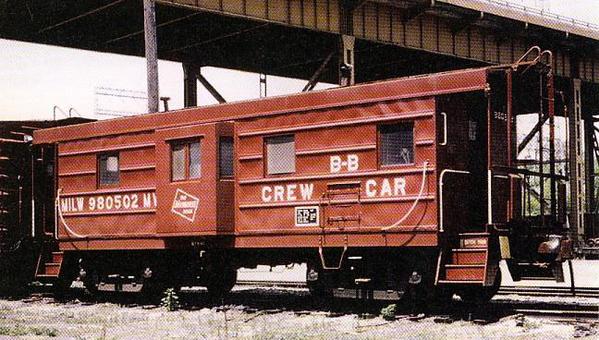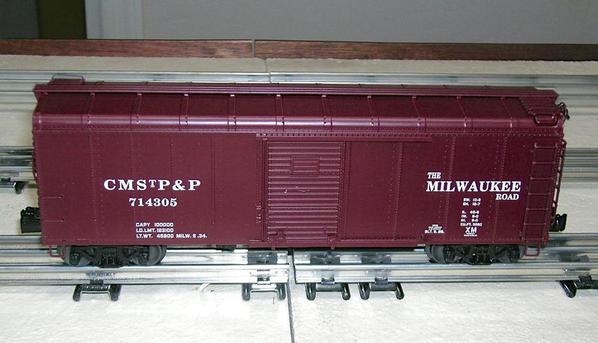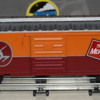There is a lot of "scale" (i.e. scale-size) rolling stock on the market that is partly or mostly prototypical, but off in one way or another. This ranges from total fantasy paint jobs to paint schemes that are correct, but not for the car to which they are being applied. Manufacturers can only make a limited assortment of body molds, given the astronomical tooling cost for a good-quality ABS freight car. The question is: What are we willing to accept? Is a manufacturer who adapts a prototypical paint job to a not-quite-right car body doing something good or bad?
Here are a few examples. Since I'm a Milwaukee Road specialist, most of them are drawn from the Milwaukee. First up, a clear-cut example of a fantasy paint scheme on a scale car body. This MTH Hiawatha boxcar bears no resemblance to anything in the real world. I ran into the MTH guy who designed it at York one time. He was perfectly frank about it - he designed it to look good and knew perfectly well it wasn't prototypical. He's a really nice guy, by the way - I can't remember his name. Perhaps ironically, when this car was released it commanded a premium price on eBay. MTH underestimated the demand for it and it sold out almost instantly. Prices have since come back to earth. I got mine after the price spike - it's a nice looking car, but no way was I going to pay 50% over MSRP for a fantasy car!
This K-Lionel caboose is a very good rendition of a Milwaukee Road crew car (work train caboose). The only problem is that the prototype was a ribside caboose built in the Milwaukee Shops,not a smooth-sided bay window caboose. K-Line put an excellent copy of the graphics on their generic bay window caboose, which resembles Thrall cabooses bought be the Milwaukee Road in the 1950's. A praiseworthy effort to create something almost prototypical, knowing that it was unlikely that anybody would ever make a fully correct one, or something that shouldn't have been built at all, since it wasn't a scale model of the prototype? Personally, I'm glad to have it in the full knowledge that it isn't quite right. The only way I'm ever going to have one that's 100% right is to buy and paint a brass one. I don't want a perfect one that badly, but I'm content with the "almost" version.
Here's a Milwaukee Road round-roof boxcar, by Lionel for the Milwaukee Lionel RRC. The prototype for the Lionel car is a Pennsylvania RR car, but Lionel has issued it decorated for other railroads that had round-roof boxcars, including the Seaboard and the Milwaukee. The prototype Milwaukee Road car was all-welded (as you can see in the photo, the Lionel/Pennsy car is riveted) and the Seaboard prototype also was not identical to the PRR one. Should Milwaukee and Seaboard fans be happy that Lionel has offered something resembling the prototype, or annoyed that it isn't fully prototypical? Personally, I'm happy. The Milwaukee prototype had an old-style vertical brake stand; one of these days I'll change the brake wheel on my car.
Here's another example, this time from Atlas and K-Line. Shortly before the company went under, K-Line came out with a 40' woodside reefer of near-Atlas quality and detail. Some of the cars they made were actually from 36' prototypes - but given that they only had the 40' mold, should they have stuck to 40' prototypes, or was it OK for them to do reefers like the Oppenheimer, which were 36-footers in the real world? Atlas 36-footer at lower left, K-Line to the right.
And finally, here's an item that's neither fantasy nor prototypical. It was a design done by the Milwaukee Road shortly before it went out of business, but never actually put on a boxcar. The Milwaukee Lionel RRC found this in the railroad archives and issue it as a club car. The car is traditional Lionel, but I'd love to see the decoration scheme done on a scale car, exactly as it would have been if the railroad had survived.
What do we think of these compromises, and what will we buy or not buy? Let's confine the discussion to scale-size rolling stock. Rail King and traditional Lionel is another game entirely.
Personally, I would like to see more disclosure. I'd love to see a sheet in the box of a boxcar saying "This paint scheme was used on some of Railroad X's boxcars, but not on the PS-1 car as we have painted it. This is as close as we can get to the prototype within our range of molds." However, I am fully aware that this is NEVER going to happen.
Let's hear what y'all have to say.














